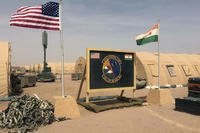The $11.7 billion the U.S. has sunk into facilities housing Afghan military and police forces will likely go to waste once U.S. and coalition forces leave Afghanistan, according to a report by the Special Inspector General for Afghanistan Reconstruction.
U.S. taxpayers continue to provide the bulk of funding for the Afghan national security forces leaving questions about the status of those facilities once that amount of support is drastically reduced after 2014. In the IG's latest report, the inspectors found the Afghan government has made small steps toward maintaining these facilities, but not enough progress has been made once U.S. support is pulled back.
"[The Ministry of Interior] has not recruited the necessary personnel and implemented the systems required to develop a self-sustaining police force. Instead, the ministry continues to rely on U.S. and coalition funding and support, decreasing the likelihood that the ministry will be able to sustain [Afghan National Police] facilities in the long run." the inspectors wrote. "As a result, U.S. funds invested in the construction and maintenance of ANSF facilities, particularly police facilities, are at risk of being wasted."
Afghanistan faces significant challenges toward sustaining the military that the U.S. has built for it. Leading the pack is the fact that 90 percent of the Afghan soldiers and policemen can't read.
Second is funding. The U.S. dedicated $800 million starting in 2011 to provide operations and maintenance for Afghan facilities until the Afghans can take over the job themselves. That was supposed to provide O&M through 2015. However, the funding will dry up in March 2014, according to the IG report.
U.S. contractor ITT Exelis Systems Corporation provides most of the O&M for Afghan facilities. For the most part, inspectors gave the contractor middling grades, however, they questioned whether ITT charged the government for work outside their contract.
The U.S. Army Corps of Engineers couldn't verify that ITT was charging for work outside of their contract because the Army Corps was "not implementing standardized procedures for overseeing service contracts and Exelis’ incomplete implementation of quality control efforts," according to the IG report.
The Pentagon knows it has a problem in transitioning Afghan national security force facilities over to the Afghans along with a host of other logistics challenges. However, Defense Department officials said these audits are helpful toward tackling those problems while the U.S. has a little more than a year in Afghanistan.
“I think we’ve been very clear-eyed in our public statements about the fact that, while we’re making progress, challenges remain,” said George Little, the Pentagon spokesman. “I think reports such as this are helpful in identifying some of the issues we continue to confront, and we certainly take their concerns on board.”
U.S. officials faced similar logistical problems in Iraq a year before U.S. forces were set to leave. U.S. Army logistics leaders scrambled to prepare Iraqis to support their own military without U.S. aid.
However, Iraqis couldn't execute basic logistical services such as delivering spare parts to units before their U.S. trainers left. The U.S. spent millions of pristine warehouses stocked full with Humvee parts. Unfortunately, those parts rarely made it to the units who needed them.
U.S. logistical leaders face a steeper challenge with the Afghanistan national security forces. The IG found the Afghan Ministries of Interior and Defense lack personnel with even the most basic budgeting and logistical skills.
“The complexity of these critical facilities requires skilled, experienced personnel who can operate and maintain them independently, which most Afghan personnel are currently unable to do. For example, Exelis officials told us that an individual must be able to read O&M and technical manuals and blueprints in order to operate power and waste water treatment plants.”
Here is the entire report in its entirety.








